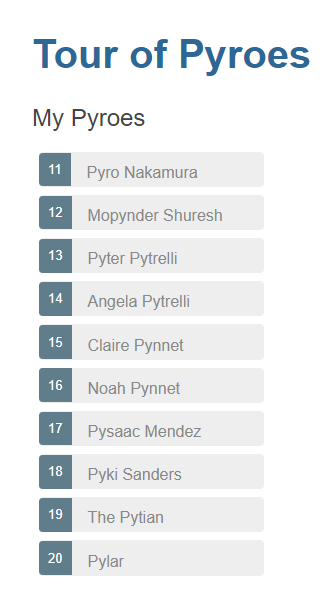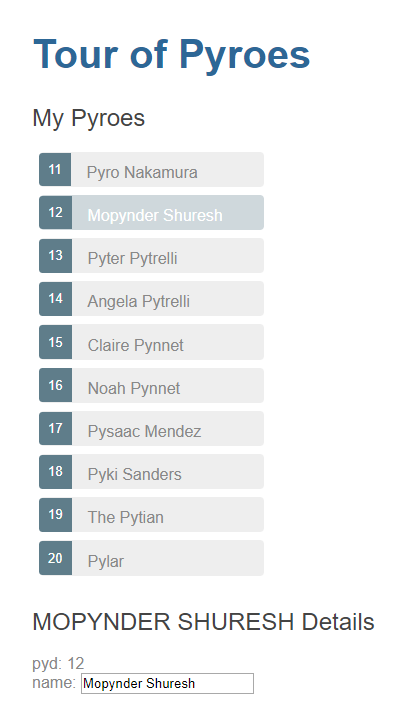Part 4 - Service Providers¶
Listing Pyroes and editing them is fine and good, but at the moment the application is completely isolated from the world: the Pyroes are defined within the application itself.
Being all this about web development, and thus: Networking, it would be good if we could actually fetch the Pyroes from a server.
Although that would be ideal, we’ll start by creating a fake service which will give us the Pyroes, just like if we had connected to the network. This will serve as another cornerstone before carrying on.
Copy the top3 folder to top4 and enter it. For example, with:
cp -r top3 top4
cd top4
Note
Under Windows and unless you have a proper shell installed (Cygwin, MSYS, GitBash, …) you are probably better off using the Windows Explorer to make a copy of the directory)
Adding a PyroService¶
A service in AnPyLar has no specific requirements: the attributes and API (methods) are for the end user to define.
Note
A Service base class might be implemented in the future giving
services certain default properties, like parent-child
relationships, but this is not foreseen at the moment.
Let’s place a PyroService simply inside a pyro_service.py module
(remember that we like consistent naming conventions)
The project layout now
├── app
│ ├── pyro_detail
│ │ ├── __init__.py
│ │ ├── pyro_detail_component.css
│ │ ├── pyro_detail_component.html
│ │ └── pyro_detail_component.py
│ ├── pyroes
│ │ ├── __init__.py
│ │ ├── pyroes_component.css
│ │ ├── pyroes_component.html
│ │ └── pyroes_component.py
│ ├── __init__.py
│ ├── app_component.css
│ ├── app_component.html
│ ├── app_component.py
│ ├── app_module.py
│ ├── mock_pyroes.py
│ ├── pyro.py
│ └── pyro_service.py
├── anpylar.js
├── index.html
├── package.json
└── styles.css
We keep mock_pyroes.py in place with the definition of our Pyroes,
because the service will at this point in time source the data from it.
The service and its placement¶
from anpylar import Observable
from .mock_pyroes import Pyroes
class PyroService:
def get_pyroes(self):
return Observable.of(Pyroes)
from anpylar import Module
from .app_component import AppComponent
from .pyro_service import PyroService
class AppModule(Module):
components = AppComponent
bindings = {}
services = {
'pyro_service': PyroService,
}
routes = {}
def __init__(self):
pass
from anpylar import Component, html
from app.pyro import Pyro
class PyroesComponent(Component):
bindings = {
'selected': Pyro(),
'pyroes': [], # observable for receiving pyroes
}
def __init__(self):
# get the pyroes from service into the observable
self.pyro_service.get_pyroes().subscribe(self.pyroes_)
def render(self, node):
with node.select('ul') as ul: # find node where to display the list
# Render under "ul" using
# callback: render_pyroes
# when: the observable self.pyroes_ is signaled
ul._render(self.render_pyroes, self.pyroes_)
def render_pyroes(self, pyroes):
# Because this was registered with ul._render, any rendering action
# takes place under ul, which is empty when entering here
for pyro in pyroes:
with html.li() as li: # create a list item per Pyro
# if the selected pyro is this pyro ... set a class attr
li._class.selected(self.selected_.pyd_ == pyro.pyd)
# bind a click to do self.selected_(pyro)
li._bindx.click(self.selected_, pyro)
# show the pyd in a <apan> as a badge (child of list item)
html.span(pyro.pyd, Class='badge')
# show the name as text inside the list item
html.txt(' {name}')._fmt(name=pyro.name_)
Defining the service and setting it in motion hasn’t actually taken that much:
The service in
pyro_service.pyis a simple class with a single method, which returns an Observable madeofthe Pyroes that we have inmock_pyroes.pyThe source could have been anything else. The important part here is that the return value that will be expected is an Observable, i.e.: callers will be able to subscribe to it
Getting it up and running means simply adding it to the
servicesdirective (a dictionary) in the application moduleAppModule.services = { 'pyro_service': PyroService, }This will make the service available to any component (and its subcomponents) as an attribute
self.pyro_service
With that knowledge in mind, we have also modified our PyroesComponent
code:
A new binding called
pyroesis added, which will receive the Pyroes from the servicebindings = { 'selected': Pyro(), 'pyroes': [], # observable for receiving pyroes }The observable for the Pyroes is fetched from the service during
__init__. Each event generated by the observable will be sent toself.pyroes_which is itself an observable (actually more a Subject). The reason is that even in this example we assume that the service could be contacting the network, i.e.: we don’t know when the result will be delivered.Observables in AnPyLar are also callables and that’s why we can pass
self.pyroes_as the subscriptor.def __init__(self): # get the pyroes from service into the observable self.pyro_service.get_pyroes().subscribe(self.pyroes_)In
renderand instead of rendering, we tell the node<ul>to delegate rendering (with the supercharged method_render) to the methodself.render_pyroeswhenever the Observableself.pyroes_has something to observe.def render(self, node): with node.select('ul') as ul: # find node where to display the list # Render under "ul" using # callback: render_pyroes # when: the observable self.pyroes_ is signaled ul._render(self.render_pyroes, self.pyroes_)
Effectively:
The code to generate the render on-screen list is the same as before
The code has been moved to method which is asynchronously invoked when
self.pyroesis set via its associated observableself.pyroes_Asynchronous being the key, because it is unknown when the service will deliver the Pyroes
Note
As indicated above, in this example the Pyroes are still simply being gotten from a list, but now we have prepared the app for more
Let’s execute¶
We haven’t changed the functionality, simply how we distribute the functionality across components. The results are the same as in the previous examples.
anpylar-serve top4
And go the browser
And our list of Pyroes will be displayed

Clicking on one of the Pyroes will:
Open the editor
Change the class of the selected Pyro so that it becomes highlighted

And making changes in the editor is automatically reflected not only in the
input field, but also in the uppercased name in the editor and in the list
of Pyroes
